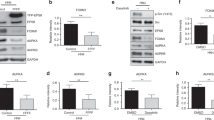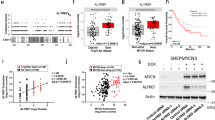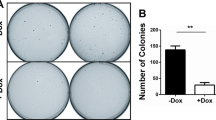Abstract
V-SEA is the transforming component of S13 Avian Erythroblastosis Retrovirus that causes erythroblastosis and anemia in chicken. Like all members in the family (MET, RON, SEA), its cytosolic domain possesses two tyrosine autophosphorylation sites in the tandemly arranged bidentate motif that serve as docking sites for SH2 domain-containing proteins. Here, we investigated phosphotyrosine-dependent activation of signaling pathways and their significance in V-SEA-induced transformation and/or proliferation. We demonstrated that V-SEA activates the PI3K-Akt signaling pathway primarily in Y557- and secondarily in Y564-dependent manner. V-SEA was also shown to induce the tyrosine phosphorylation of the Gab2 protein, leading to PI3K association and thus providing an alternative route for PI3K activation. On the other hand, activation of the Ras-ERK pathway is primarily via Y564 and secondarily via Y557. A dominant-negative form of Ras inhibited V-SEA-induced ERK phosphorylation in concentration dependent manner suggesting the importance of the Grb2-Ras signaling axis in V-SEA-induced ERK activation. The biological significance of activation of the PI3K-Akt and the Ras-ERK pathways in V-SEA-induced transformation was analysed in the V-SEA-RAT1 and V-SEA-3T3 cell lines by employing specific inhibitors, LY294002 and PD98059 compounds. Both the PD and LY compounds inhibited cell growth, but only the PD compound caused reversion of the transformed phenotype. In addition, both compounds inhibited focal colony formation by the transformants in soft agar. Thus, transformation by the V-SEA oncogene is a function of the concomitant activation of, at least, the PI3K-Akt and Ras-ERK signaling pathways that regulate cell growth and morphology.
This is a preview of subscription content, access via your institution
Access options
Subscribe to this journal
Receive 50 print issues and online access
$259.00 per year
only $5.18 per issue
Buy this article
- Purchase on Springer Link
- Instant access to full article PDF
Prices may be subject to local taxes which are calculated during checkout








Similar content being viewed by others
References
Anderson KE, Coadwell J, Stephens LR, Hawkins PT . 1998a Curr. Biol. 8: 684–691
Anderson MJ, Viars CS, Czekay S, Cavenee WK, Arden KC . 1998b Genomics 47: 187–199
Alessi DR, James SR, Downes CP, Holmes AB, Gaffney PR, Reese CB, Cohen P . 1997 Curr. Biol. 7: 261–269
Aoki M, Schetter C, Himly M, Batista O, Chang HW, Vogt PK . 2000 J. Biol. Chem. 275: 6267–6275
Baker JM, Myers Jr MG, Shoelson SE, Chin DJ, Sun XJ, Miralpeix M, Hu P, Margolis B, Skolink EY, Schlessinger J, White MF . 1992 EMBO J. 11: 3469–3479
Bardelli A, Basile ML, Audero E, Giordano S, Wennstrom S, Menard S, Comoglio PM, Ponzetto C . 1999 Oncogene 18: 1139–1146
Borlado LR, Redondo C, Alvarez B, Jimenez C, Criado LM, Flores J, Marcos MAR, Martinez AC, Balomenos D, Carrera AC . 2000 FASEB J. 14: 895–903
Bornfeldt KE, Gidlof RA, Wasteson A, Lake M, Skottner A, Arqvist HJ . 1991 Diabetologica 34: 307–313
Brunet A, Bonni A, Zigmond MJ, Lin MZ, Juo P, Hu LS, Anderson MJ, Arden KC, Belnis J, Greenberg ME . 1999 Cell 96: 857–868
Cantley LC, Auger KR, Carpenter C, Duckworth B, Graziani A, Kapeller R, Soltoff S . 1991 Cell 64: 281–302
Chang HW, Aoki M, Fruman D, Auger KR, Bellacosa A, Tsichlis PN, Cantley LC, Roberts TM, Vogt PK . 1997 Science 276: 1848–1850
Cooper CS, Park M, Blair DG, Tainsky MA, Huebner K, Croce CM, Vande Woude G . 1984 Nature 311: 29–33
Corbalan-Garcia S, Margarit SM, Galron D, Yang S-S, Bar-Sagi D . 1998 Mol. Cell. Biol. 18: 880–886
Cowley S, Paterson H, Kemp P, Marshall CJ . 1994 Cell 77: 841–852
Crews GM, Alessandrini A, Erikson RL . 1992 Science 258: 478–480
Datta SR, Katsov A, Hu L, Petros A, Fesik SW, Yaffe MB, Greenberg ME . 2000 Mol. Cell. 6: 41–51
End P, Gout I, Fry MJ, Panayotou G, Dhand R, Yonezawa K, Kasuga M, Waterfield MD . 1993 J. Biol. Chem. 268: 10066–10075
Fan S, Ma YX, Wang J-A, Yuan R-Q, Meng Q, Cao Y, Laterra JJ, Goldberg ID, Rosen EM . 2000 Oncogene 19: 2212–2223
Fixman ED, Fournier TM, Kamikura DM, Naujokas MA, Park M . 1996 J. Biol. Chem. 271: 13116–13122
Gale NW, Kaplan S, Lowenstein EJ, Schlessinger J, Bar-Sagi D . 1993 Nature 363: 88–92
Graziani A, Gramaglia D, Cantley LC, Comoglio PM . 1991 J. Biol. Chem. 266: 22087–22090
Greco M, Santoro M, Berlingieri MT, Melillo RM, Donghi R, Bongarzone I, Pierotti MA, Della Porta G, Fusco A, Vecchio G . 1992 Oncogene 7: 237–242
Gu H, Maeda H, Moon JJ, Lord JD, Yoakim M, Nelson BH, Neel BG . 2000 Mol. Cell. Biol. 20: 7109–7120
Hayman MJ, Kitchener G, Vogt PK, Beug H . 1985 PNAS 82: 8237–8241
Hibi M, Hirano T . 2000 Leuk. Lymph. 37: 299–307
Huff JL, Jelinek MA, Borgman CA, Lansing TJ, Parsons JT . 1993 PNAS 90: 6140–6144
Iwama A, Yamaguchi N, Suda T . 1996 EMBO J. 15: 5866–5875
Jiang B-H, Zheng JZ, Aoki M, Vogt PK . 2000 Proc. Natl. Acad. Sci. USA 97: 1749–1753
Jimenez C, Jones DR, Rodriguez-Viciana P, Gonzalez-García A, Leonardo E, Wennström S, von Kobbe C, Toran JL, Borlado LR, Calvo V, Copin SG, Albar JP, Gaspar ML, Diez M, Marcos MAR, Downward J, Martinez-A C, Mérida I, Carrera AC . 1998 EMBO J. 17: 743–753
Kennedy SG, Kandel ES, Cross TK, Hay N . 1999 Mol. Cell. Biol. 19: 5800–5810
Knight J, Smith DR, Hayman MJ . 1990 Virology 178: 232–237
Lowenstein EJ, Daly RJ, Batzer AG, Li W, Margolis B, Lammers R, Ullrich A, Skolnik EY, Bar-Sagi D, Schlessinger J . 1992 Cell 70: 431–442
Maroun CR, Holgado-Madruga M, Yoyal I, Naujokas MA, Fournier TM, Wong AJ, Park M . 1999 Mol. Cell. Biol. 19: 1784–1799
Morimoto AM, Hayman MJ . 1994 J. Virol. 68: 1837–1842
Nishida K, Yoshida Y, Itoh M, Fukada T, Ohtani T, Shirogane T, Atsumi T, Takahashi-Tezuka M, Ishihara K, Hibi M, Hirano T . 1999 Blood 93: 1809–1816
Park CY, Hayman MJ . 1999 J. Biol. Chem. 274: 7583–7590
Park M, Dean M, Cooper CS, Schmidt M, O'Brien SJ, Blair DG, Vande Woude G . 1986 Cell 45: 895–904
Park M, Dean M, Kaul K, Braun MJ, Gonda MA, Vanda Woude G . 1984 PNAS 84: 6379–6383
Pawson T . 1995 Nature 373: 573–580
Ponzetto C, Bardelli A, Maina F, Longati P, Panayotou G, Dhand R, Waterfield MD, Comoglio PM . 1993 Mol. Cell. Biol. 13: 4600–4648
Ponzetto C, Zhen Z, Audero E, Maina F, Bardelli A, Basile ML, Giordano S, Narsimhan R, Comoglio PM . 1996 J. Biol. Chem. 271: 14119–14123
Potempa S, Ridley A . 1998 Mol. Cell. Biol. 9: 2185–2200
Reed JC . 1998 Oncogene 17: 3225–3236
Rordorf-Nikolic T, Van Horn DJ, Chen D, White MF, Backer JM . 1995 J. Biol. Chem. 270: 3662–3666
Royal I, Lamarche-Vane N, Lamorte L, Kaibuchi K, Park M . 2000 Mol. Cell. Biol. 11: 1709–1725
Schaeper U, Gehring NH, Fuchs KP, Sachs M, Kempkes B, Birchmeier W . 2000 J. Cell Biol. 7: 1419–1432
Smith DR, Vogt PK, Hayman MJ . 1989 PNAS 86: 5291–5295
Stephens L, Anderson K, Stockoe D, Erdjument-Bromage H, Painter GF, Holmes AB, Gaffney PR, Reese CB, McCormick F, Tempst P, Coadwell J, Hawkins PT . 1998 Science 279: 710–714
Tang X, Downes CP, Whettons AD, Owen-Lynch PJ . 2000 J. Biol. Chem. 275: 13142–13148
Tulasne D, Paumelle R, Weidner KM, Vandenbunder B, Fafeur V . 1999 Mol. Cell. Biol. 10: 551–565
Wahl R, Hsu R-Y, Huff JL, Jelinek MA, Chen K, Courchesne P, Patterson SD, Parson JT, Welcher AA . 1999 J. Biol. Chem. 274: 26361–26368
Whitman M, Kaplan DR, Schaffhausen B, Cantley L, Roberts TM . 1985 Nature 315: 239–242
Wichrema A, Uddin S, Sharma A, Chen F, Alsayed Y, Ahmad S, Sawyer ST, Krystal G, Yi T, Nishada K, Hibi M, Hirano T, Platanias LC . 1999 J. Biol. Chem. 274: 24469–24474
Zhao C, Yu D-H, Shen R, Feng G-S . 1999 J. Biol. Chem. 274: 19649–19654
Author information
Authors and Affiliations
Corresponding author
Rights and permissions
About this article
Cite this article
Agazie, Y., Ischenko, I. & Hayman, M. Concomitant activation of the PI3K-Akt and the Ras-ERK signaling pathways is essential for transformation by the V-SEA tyrosine kinase oncogene. Oncogene 21, 697–707 (2002). https://doi.org/10.1038/sj.onc.1205115
Received:
Revised:
Accepted:
Published:
Issue Date:
DOI: https://doi.org/10.1038/sj.onc.1205115
Keywords
This article is cited by
-
Inhibition of SHP2 leads to mesenchymal to epithelial transition in breast cancer cells
Cell Death & Differentiation (2008)
-
Role of iNOS-derived reactive nitrogen species and resultant nitrative stress in leukocytes-induced cardiomyocyte apoptosis after myocardial ischemia/reperfusion
Apoptosis (2007)
-
Hypoxia/Reoxygenation Stimulates Proliferation Through PKC-Dependent Activation of ERK and Akt in Mouse Neural Progenitor Cells
Neurochemical Research (2007)
-
Modulation of α-catenin Tyr phosphorylation by SHP2 positively effects cell transformation induced by the constitutively active FGFR3
Oncogene (2006)
-
Ron tyrosine kinase receptor regulates papilloma growth and malignant conversion in a murine model of skin carcinogenesis
Oncogene (2005)



